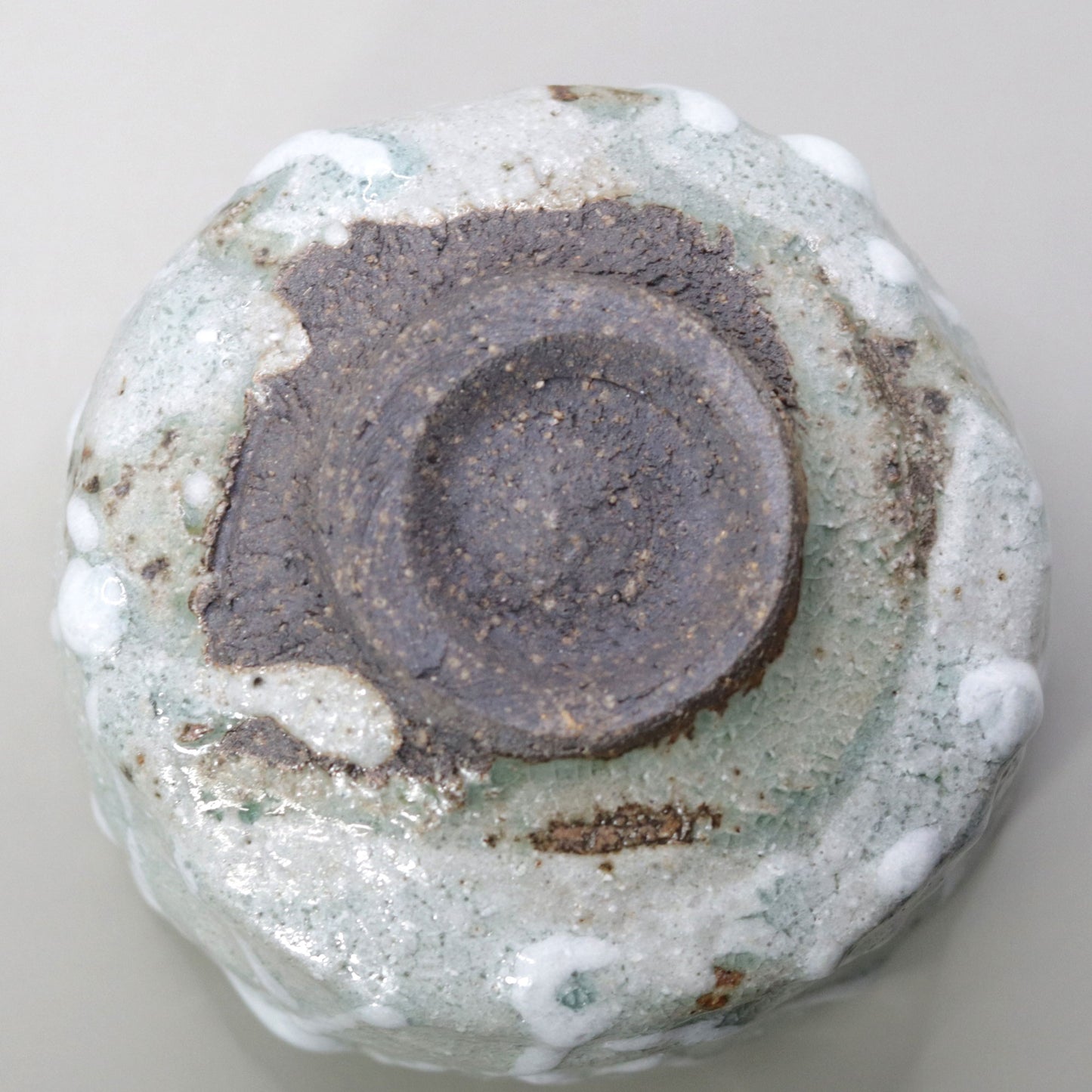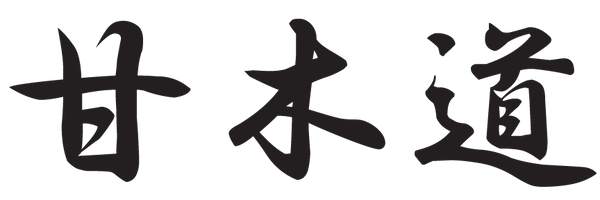Width: 11.5cm Height: 8.2cm
Beautiful colors and perfect balance
Yuichi Ikai's "Ash Glazed Sansai Tea Bowl" is a vibrant matcha bowl made with a variety of glazes. The subtle differences in color are an element that entertains the viewer without ever tiring of looking. It goes without saying that the well-balanced rhythm of the sansai in this piece, the milky white color and the beauty of the foot are beautiful, but the most noteworthy aspect is its shape.
The tension of independent forms
One wrong step and the freestanding design could easily evoke the shadow of the Showa era, but Ikai has given it an exquisite balance and a very tasteful finish. The moderate curves in particular feel good in the hand, and while it is more practical than it looks, it does not lose its beauty. This design, beautiful from any angle, is a concentrated expression of keen sensibility and skill.
Sansai contrast and evolution of form
The milky white color emerges clearly on the green glaze, and the way the glaze is removed and accumulated on the sides of the foot is truly exquisite. Furthermore, the shape of the foot itself has evolved to an amazing extent, and the milky white color paints a clear picture even at the back of the bowl. Every time you look at this tea bowl, you will discover something new, and its rich expressions will never run out.
Cultural assets to be passed on to future generations
The sense of tension and style of this piece makes it stand out even among contemporary ceramic works, and it is a valuable cultural asset that should be passed on to future generations. Yuichi Ikai's work is a rare fusion of traditional techniques and modern aesthetics, and its powerful beauty of form and the future of ceramics are a glimpse into its creation.
Yuichi Ikai Biography
1963 (1963)
Born into a pottery merchant in Gojozaka, Kyoto
1983 (1983)
Graduated from Kyoto Prefectural Pottery Training School, Molding Department
1984 (1984)
・Completed ceramics training at Kyoto Municipal Industrial Research Institute
・Under the guidance of the late Mr. Uichi Shimizu, a holder of the Important Intangible Cultural Property,
June: Kihei Kiln opens (from the shop name, Kihei the Sixth)
・Studied under Uichi and Yasutaka Shimizu
1985 (1985)
・First time selected for the Japan Crafts Association Kinki Branch Exhibition (continuously selected thereafter)
・Participated in the Cheramista Exhibition
1986 (1986)
・First time selected for the Japan Traditional Crafts Exhibition
1987 (1987)
・Permitted to exhibit at the Family Exhibition, Horai-kai (Ikebukuro Seibu) and Uzuki-kai (Osaka Matsuzakaya)
・Received the Matsushita Award at the Japan Crafts Association Kinki Branch Exhibition
・Dog Exhibition: Leading the Way in Kyoto, Kyoto Daimaru
1988 (1988)
・Participation in Chabikai Kyoto Myrieme
1989 (1989)
・Founding of the Earth Children Association (named by Uichi Shimizu)
・Received the Encouragement Award at the Japan Crafts Association Kinki Branch Exhibition
1990 (1990)
・First solo exhibition at Kuroda Touen in Ginza
・Solo exhibition at Mizutama, Itabashi
1993 (1993)
・Solo exhibition at Mitsukoshi, Osaka (continues to be held)
1994 (1994)
・Certified as a regular member of the Japan Crafts Association
・Solo exhibition at Gallery Kiyomizu, Matsuyama (will continue to be held in the future)
・Received the Encouragement Award at the Saga Daikakuji Flower Ceramics Exhibition
1995 (1995)
・Solo exhibition at Daimaru, Kyoto (continues to be held)
・Solo exhibition at Hankyu Kobe (continues to be held)
1996 (1996)
・The workshop was moved to Hiyoshicho, Nantan City, Kyoto Prefecture.
・Solo exhibition at Gallery Kurimoto, Nagaoka, Niigata (will continue to be held)
・Exhibition of Contemporary Ceramic Artists Living in Kyoto, Kyoto Daimaru
1997 (1997)
・Ceramics Three-person Exhibition, Shinjuku Isetan (Takahiro Kondo and Masahiko Ichino)
1998 (1998)
・Kyoto Talented Artists Exhibition, Hiroshima Sogo
1999 (1999)
・Solo exhibition at Shimonoseki Daimaru
2000 (2000)
・Solo exhibition at Yu, Tokyo Palace Hotel (continues to be held)
・Solo exhibition at Rakuchu Rakugai Gallery, Kyoto Kiyomizu-yaki Complex
・Exhibited at the Tsinghua University International Ceramic Exhibition in Beijing, China
2001 (2001)
・Received the highest award, the Kinki Prize, at the 30th Kinki Exhibition of Japanese Traditional Crafts
・Solo exhibition at Tenmaya, Mihara, Hiroshima
2002 (2002)
・Solo exhibition at Kogei Ima, Ginza, Tokyo
・Solo exhibition at Mitsukoshi Main Store, Nihonbashi, Tokyo
・CRIA Exhibition, Kyoto Art Center
2003 (2003)
・Received the Shiga Prefecture Board of Education Award at the 32nd Japanese Traditional Crafts Kinki Exhibition
・Ginza Kuroda Touen Celadon Exhibition (still held)
・Solo exhibition at Meitetsu Department Store, Nagoya
・Exhibited at the Contemporary Korean-Japanese Ceramic Art Exhibition at the Kumho Museum of Art, Seoul
・Solo exhibition at Gion Konishi, Kyoto
2004 (2004)
・Appointed as a judge at the 33rd Japanese Traditional Crafts Kinki Exhibition
2005 (2005)
・Solo exhibition at Daimaru Art Gallery, Kyoto
・Specially selected for the 34th Japanese Traditional Crafts Kinki Exhibition
2006 (2006)
・Three Potters Exhibition, Kyoto Takashimaya
・Exhibited at the Contemporary Ceramic Artists Exhibition at Kobe Sogo
・Four Artists Exhibition at Nara Kintetsu
・Solo exhibition at Gallery Wada, Ishibekoji, Kyoto (will continue to be held)
・Solo exhibition at Dojima Gallery, Osaka (will continue to be held)
・Solo exhibition at Mitsukoshi Main Store Art Gallery, Nihonbashi, Tokyo
2007 (2007)
・Solo exhibition at Rokujido, Ninenzaka, Kyoto
・Solo exhibition at Keihan Department Store, Moriguchi, Osaka
・Climbing kiln construction
2008 (2008)
・Solo exhibition at Gallery Uko, Bashamichi, Yokohama
・Solo exhibition at Kintetsu Department Store, Saidaiji Temple, Nara
2009 (2009)
・Solo exhibition at Takashimaya, Kyoto
・Solo exhibition at Mitsukoshi Main Store Art Gallery, Nihonbashi, Tokyo
2010 (2010)
・Solo exhibition at Mizutama, Itabashi (will continue to be held in the future)
2011 (2011)
・Solo exhibition at JR Osaka Mitsukoshi Isetan, Umeda, Osaka
2012 (2012)
・Solo exhibition at Rokujido, Ninenzaka, Kyoto
・Solo exhibition at Fukuoka Mitsukoshi Department Store, Hakata
・Solo exhibition at Kairo Gallery Mon, Kasama, Ibaraki
2015 (2015)
・Solo exhibition at Hankyu Umeda Main Store, Osaka Umeda (will continue to be held)
2016 (2016)
・Solo exhibition at Atelier Hiro, Yodoyabashi, Osaka (will continue to be held)
2017 (2017)
・Established a workshop again in Gojozaka, Kyoto
2018 (2018)
・Solo exhibition at Gallery Yamazaki, Ningyocho, Nihonbashi, Tokyo (will continue to be held)
2022 (2022)
・Appointed as Secretary General of the Kinki Branch of the Japan Crafts Association, a public interest incorporated association
・Appointed as director of the Japan Crafts Association, a public interest incorporated association
・Appointed as director of the Kyoto Ceramic Association, a general incorporated foundation
・Appointed as director of the general incorporated foundation KYOTO KILIN
・A pottery store that had been in business for generations on Gojozaka closes and begins renovations
2023 (2023)
・As a showroom for "Tsuboya Kibe Kiln"
A conversation with Yuichi Ikai














